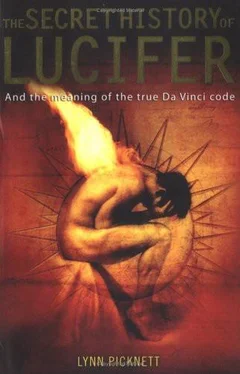The usual plan was to torture the victims until they confessed to trafficking with the Devil, then torture them further to elicit a list of accomplices, who were then pulled in for questioning, and so the process began again - until whole districts fell to the hysteria. One woman said to her interrogator:
I never dreamed that by means of the torture a person could be brought to the point of telling such lies as I have told. I am not a witch, and I have never seen the devil, and still I had to plead guilty to myself and denounce others.'84
When a cleric urged another woman to retract her accusations of innocent villagers, she answered forcibly:
Father, look at my legs! They are like fire - ready to burn up - so excruciating is the pain. I could not stand to have so much as a fly touch them, to say nothing of submitting again to the torture. I would a hundred times rather die than endure such frightful agony again. I cannot describe to any human being how terrific the pain actually is 85
The whole procedure was deliberately calculated to exacerbate the maximum of both terror and pain. No doubt some accused chained up in their cells could hear the shrieks and pleadings of those writhing in the torture chamber - but in any case it is likely that the prisoners would suffer the trauma of witnessing their cell-mates' post-torture distress when they rejoined them in the dungeons. Next the accused would be roughly dragged into the torture chamber and shown the instruments that might at any moment be put into use, and then finally face the Question itself, which might take the form of the strappado (as in the case of Herr Junius, above), which involved hauling the accused into the air by the arms, pinioned behind the back, then suddenly letting them drop to a foot or so above the ground. Shoulders and arms were routinely dislocated. Otherwise, flesh was torn from the body with pincers, feet and legs were smashed to pulp in `the Boot', limbs were broken and sinews torn on the rack, feet and hands were roasted over braziers, besides whippings and beatings administered routinely. One woman had flaming brimstone held to her genitals as she hung in the strappado. Most women suffered rape and worse even before they even reached the torture chamber.
That was `merely' the physical aspect of the torture. Mental torture included the build-up of terror or being forced to witness the rape or torture of close family members, perhaps children under ten (categorized as `infants'). Usually children were tortured without much preamble because of their susceptibility to the torment of the whole experience, not the least having been wrenched for reasons they could never understand from their families. Usually, though, they were fair game, and soon persuaded, one way or another, to incriminate many others, including their own mothers and fathers. Being tortured on the testimony of your eight-year-old, knowing that this child had suffered abominably, must have added enormously to the victims' agony. Such testimony was acceptable in a witch trial, but in no other kind of court, even at that time.
The records of the infamous Spanish Inquisition, based at Toledo, reveal that
some victims were prevented from confessing until the lust of their tormentors had been gratified. Their torture went on for days or weeks beyond the point where they had wholly broken down, and pleaded to be told what to say, so they could say it 86
As the European Inquisitors tended to use the more obviously brutal forms of torture compared to the methods of interrogation utilized in Britain, it might be thought that the English and Scottish witchfinders were generally more compassionate. In fact, this was hardly the case: in Britain tortures such as dunking in water ('swimming the witch'), binding tightly with ropes, sleep deprivation ('walking the witch') and so on were the order of the day. Sometimes the mob devised more hideous means of dealing with the accused. In Catton, Suffolk in 1603, an eighty-year-old woman was set upon by a gang of violent men, who punched and threw her about, flashed gunpowder in her face, and then hurled her with force on a specially constructed seat `in the which they had stuck daggers and knives with sharp points upwards, [and] they often times struck her down upon the same stool whereby she was sore pricked and grievously hurt.'x' The vivid mental picture conjured by this terse report summons the not dissimilar image of Nazi bullyboys setting fire to old Jews' beards, or dragging naked middleaged women through the streets by their hair - images that haunt long after the photograph or film footage has been removed from sight. It comes as a shock, however, to realize that intensely horrible though those particular Nazi atrocities were - and remain in the mind's eye - even they were not quite so disgusting as what happened to that anonymous eighty-year-old woman in the quiet English countryside of the 1600s.
The sheer inventiveness and sadism of the tortures and the fact that most of the accused were women reveals the real agenda of the Inquisition, as expressed by the truly demonic double act, Kramer and Sprenger. Their Hammer of the Witches makes it conclusively clear that to them, at least, witchcraft was a gender-specific crime. They write of the evils of women in openly hostile terms, speaking of them being `so beautiful to look at' but `contaminating to the touch', with sweet voices that `entice passersby and kill them .. . by emptying their purses, consuming their strength and causing them to forsake God'. To the authors of the Inquisitorial handbook, a woman is a vampire, and a `curse worse than the devil'.
The Hammer of the Witches was designed to appear authoritative, being accompanied by a papal bull from Innocent VIII, supporting the book in its campaign - virtually a crusade in itself - to eradicate witches, root and branch. There is also a supportive letter from a group of theologians from the University of Cologne, but recent scholarship has suggested it was partly forged x8 And other inconsistences indicate that the wider picture of witch-hunting was at least a little different from the accepted view. For example, Kramer claimed to have tried nearly a hundred women in the Tyrol in the early 1480s, half of whom died by fire. But the surviving records tell a different story: Kramer arrived and began inciting the populace to implicate their neighbours. Eight women were convicted and burnt, but both the local archduke and the bishop remained sceptical - the latter calling Kramer a `senile old fool' and expelling him from the town.
The reason for the bishop's hostility was that Kramer had rarely accused the women of actual diabolism: on the whole they stood trial for using love spells. In the case of Helen Scheuberin, he attacked her on the basis of her promiscuity, the details of which he seemed particularly anxious to hear until the bishop's representative ordered him to stop. The townspeople were so horrified by his blatantly salacious and perverted raison d'etre that they complained to the authorities, who threw him out. Kramer then took to composing the handbook for more successful witch-hunters, infecting thousands, for generations, with his own brand of sexist sado-masochism. It found a ready audience, however, among Catholics who had always been encouraged to `offer up their suffering to God' but not their joy, and whose every visit to Church provided yet another encounter with the images of Christ's bloody and terrible death by torture. The implacable wrath and blood lust of the patriarchal God was surely nowhere more evident than in his demand for the crucifixion of his own son.
Kramer drew on several earlier sources, particularly Johannes Dominicus' Lectiones super Ecclesiastes (1380), which blames the `natural' vices of women for their openness to the Devil's influence - greed, carnality and so on. Like Eve, women are light-hearted and therefore easily swayed by demons. Dominicus, however, had never mentioned witchcraft.
Читать дальше












